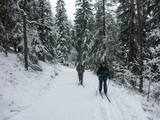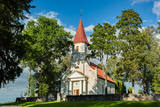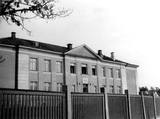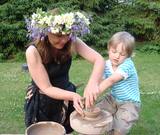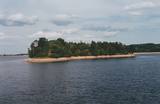| Nr | Name | Beschreibung |
|---|---|---|
|
Das Café befindet sich am Ufer des Flusses Daugava zwischen Stukmani und Plavinas und es ist mit einer Bäckerei und einem Geschäft verbunden. Mehrere dutzende Brotsorten, Gebäck, Torten, Kuchen und Brötchen. Lettische Küche: Suppe mit Fleischbällchen, Ampfersuppe, Bauernfrühstück, Spiegeleier, Schweinerippen, graue Erbsen, Kartoffelpfannkuchen mit Lachs, dünne Pfannkuchen, Brombeercreme. Das besondere Gericht: Roggenbrot von Liepkalni, Brotkwass. |
||
|
Der Naturpark von Ogre ist ein beliebter Ort für Freizeit, Wandern und im Winter für Skilanglauf. Der größte Teil des Parks ist mit Nadelwald bedeckt, der sich auf einer langen und vergleichsweise schmalen Linie von Hügeln mit steilen Abhängen befindet – ein weiteres Element der in Lettland von der Eiszeit zurückgelassenen Natur. Man findet hier viele verschiedene Pflanzen. Der Jaunogres-Burgberg ist einer der ausgeprägtesten Hügel in diesem Gebiet.
|
||
|
Dieser Biergarten befindet sich gegenüber der Brauerei Brenguļi, wo das Bier (ungefiltertes, nicht pasteurisiertes) nach dem Wissen der Vorfahren aus den Getreidekörnern gebraut wird, die von den lokalen Bauern gezüchtet worden sind. Im Biergarten kann man das helle und das dunkle Bier von Brenguļi kaufen, sowie lettische Speisen genießen. Lettische Küche: Graue Erbsen mit Speck, Würste mit Kraut, Eis von Rujiena. |
||
|
The tower is at the western end of the Seda swamp, accessed from the side of Jērcēni. Transport is limited here. The tower is in the area of the swamp where peat moss is extracted. It offers a broad view of the ponds of Seda and a boat rental facility that is nearby. It is an appropriate location for bird-watching during the season of migration. There is another bird-watching platform near the town of Seda. This is part of the ZBR. |
||
|
Jauns Zoo un izklaides vieta netālu no Siguldas, pie ceļa Turaida - Ragana. Tiks atvērts 2022. gada maijā. |
||
|
1,2 km garā taka atrodas netālu no vietas, kur Gauju šķērso Vidzemes šoseja (A 2). Izejot taku, var iepazīt vienu no Latvijas augstākajiem dolomītiežu atsegumiem – Randātu klintis, kas paceļas 25 m virs Gaujas. Taka ir apļaveida un tās apskatei nepieciešamas ~ 45 minūtes. |
||
|
The Vijciems Hunting Castle building houses an elegant design guest house Bergervilla. Each room has an individually designed design, historic furniture and a special atmosphere. There are 4 rooms available - a standard room, a two-room suite and two deluxe rooms with a private balcony and a bathtub. Each room is given the name of a forest beast or bird - Owl, Mednis, Deer and Elk. There is also a living room and library for guests to relax in, as well as a fully equipped kitchen for cooking. Free Wi-Fi and parking are available. |
||
|
Pastāv uzskats, ka tieši Rubenē izveidojusies pirmā latviešu draudze. Baznīcas altārdaļa būvēta jau 14.gs., bet pati baznīca savu pašreizējo izskatu ieguvusi 1739. gadā.Būtiska baznīcas interjera sastāvdaļa ir Ķieģeļu muižas mantinieces Barbaras Helēnas fon Budbergas 1762. gadā dāvinātais kroņlukturis ar Krievijas impērijas divgalvaino ērgli un zaru ornamentiem uz bumbas. Baznīcā redzama arī zīme (1869. g.), kas ir veltīta pusgadsimtam kopš dzimtbūšanas atcelšanas. Pastāv vairākas teikas par Rubenes baznīcas nosaukuma rašanos. Viena no tām vēsta, ka, sargājot baznīcu no velna, tās sienā iemūrēta sieviete un vīrietis, kura vārds bijis Rubens. Baznīca esot nosaukta viņam par godu.Vēl viena versija vēsta, ka baznīcas nosaukums cēlies no rubeņa, kas sēdējis kādā no kokiem, kas vēlāk izmantots baznīcas celtniecībā. |
||
|
The roots of Saulkrasti Secondary School reach back to Pabaži, to 1912, when a young teacher – Olga Veicmane (after marriage: Cīrule) arrived from Riga to teach the sea captain Reisons’ daughter. Soon many other tutor-seekers joined her and in autumn of 1912 a school was established in Pabaži. The school had a good reputation, and pupils came from the entire surrounding area. In January of 1913, the school was moved to more spacious premises at 20 Rīgas Street. |
||
|
Ein Rundweg für Wanderer und Radfahrer, der im Ort Vaidava beginnt und am Ostufer des Sees von Vaidava entlang führt. Die Route führt über den Welkenhof (Veļķu Muiža), die schwedischen Kiefer, den Burghügel von Vaidava, verschiedene Quellen, den Findling von Rubene, den Weidauer Hof (Vaidavas Muiža) am Westufer und endet am Ausgangspunkt.
|
||
|
Ap 100 gadus veca priežu audze, ko iesēja pagājušā gadsimta sākumā. Sēklu materiāls bija nācis no kādas Vācijas (Darmštatē) sēklu tirdzniecības firmas. Mūsu klimatiskajos apstākļos priežu stumbri izauga līki un kroplīgi. Savdabīgā audze labi redzama no šosejas malas.
|
||
|
The farm produces vegetables, medicinal plants and honey. You can look at Charolais cattle and buy products. The lady of the house will talk about her experience in relation to her farm and biological farms that are in the neighbourhood. |
||
|
Das Museum „Kaikaši” befindet sich ~ 1 km südwestlich vom Zentrum der Stadt Vecpiebalga, in einer kleinen Ortschaft Kaikaši. Auf dem Hof „Kaikaši” ist ein lettischer Schriftsteller Antons Austriņš (1884 – 1934) geboren. In Vecpiebalga hat der künftige Schriftsteller eine Grundallgemeinbildung erhalten. Eins der bekanntesten Werke von A. Austriņš ist das Geschichtenbuch „Jünglein” (1931). Das Museum, in dem sich verschiedene Gegenstände des ländlichen Alltagslebens und mit dem Schriftsteller verbundene Exponate (auch geschriebene Sammelbände und Bücher) befinden, lohnt es sich, unter Begleitung von örtlichem Guide zu besichtigen. |
||
|
Aus Lehm, Steinmasse und anderen Materialien formt die Töpferin Geschirr und verschiedene Gegenstände für Innenausstattung und sie brennt ihre Werke in einem offenen Brennofen. Die Besucher können hier an einer Führung teilnehmen, die Handwerkerin bei ihrer Arbeit beobachten, selber eine Tasse formen, sowie die Werkstatt beim Öffnen des Brennofens besuchen. |
||
|
Das ist eines der am interessantesten geschützten Territorien der Stadt Riga und sein Ziel besteht im Schutz der Küstenbiotope – Dünen und Küstenwiesen und die Vögel und Pflanzen, die hier gefunden werden (unter ihnen 29% der Orchideenarten). Es gibt einen markierten Informationspfad mit einem Vogelbeobachtungsturm. Es ist der einzige Aussichtsturm in Lettland im Freien, der für Rollstuhlfahrer geeignet ist.
|
||
|
Before its flooding, the canyon of the Daugava River between Pļaviņas and Koknese was one of the most outstanding and beautiful parts of the Baltic terrain, and Oliņkalns hill was one of the largest castle hills in Latvia. The Andrejs cliff as up to 20 metres high, and it was part of the Daugava canyon. Before the area was flooded because of the construction of the Pļaviņas hydroelectric power plant, there were rapids near the hill that made it hard for rafters to sail down the river. Today it is a small island in the reservoir of the plant (it can be seen from the side of the Rīga-Daugavpils highway (A6) opposite Stukmaņi). It is separated from the shore by 300 metres of river, under which the Dūņas valley is now resting. A small part of the ramparts of the castle hill can still be seen on the island along with the ruins of an open-air stage and a few metres of the dolomite cliff that have remained above water. It is thought that the Alene castle was on the hill in the 13th century. Latvian mountain climbers installed a memorial stone in 1998 opposite Oliņkalns hill. |
||
|
Bestes Apartments is a new guest house that can accommodate 45 guests at a time (+ 10 extra beds). The guest house was built and designed in the Latvian style (a wooden building made here in Mūrmuiža), beds made in Latvia, bed linen made in Latvia were used. |
||

